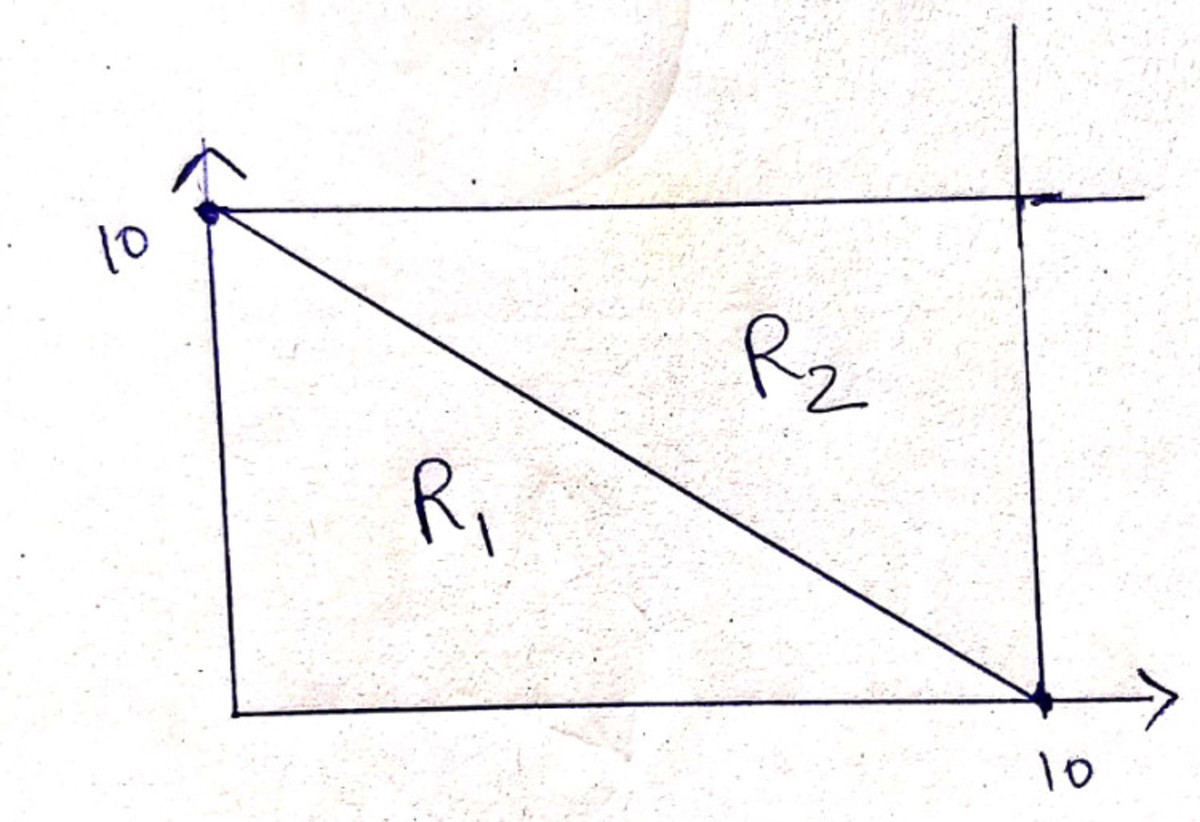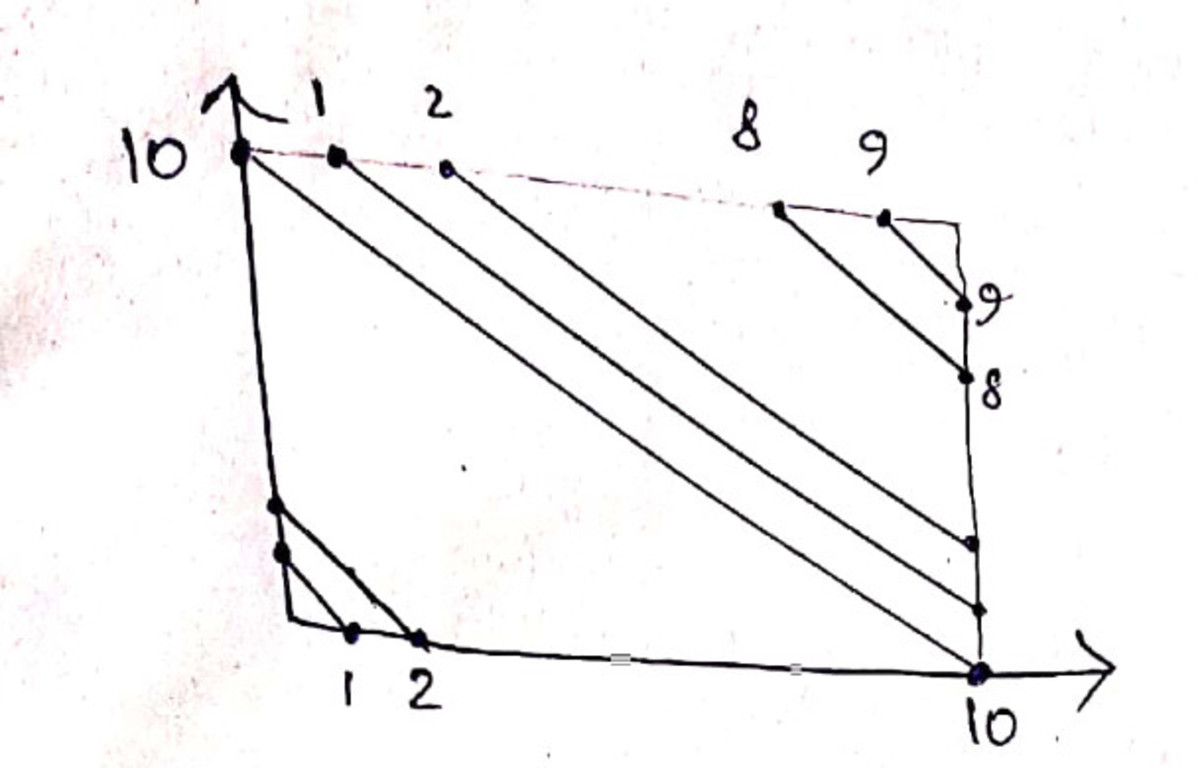This section requires Javascript.
You are seeing this because something didn't load right. We suggest you, (a) try
refreshing the page, (b) enabling javascript if it is disabled on your browser and,
finally, (c)
loading the
non-javascript version of this page
. We're sorry about the hassle.
3 solutions
Wow, nice work. We can generalize this to ∫ 0 n ∫ 0 n ⌊ x + y ⌋ d x d y = 2 1 n 2 ( 2 n − 1 ) for all non-negative integers n .
Can we generalize this even further?
Let us divide the square formed by
x
=
0
,
x
=
1
0
,
y
=
0
,
y
=
1
0
into two regions
R
1
and
R
2

Now let us draw the lines x + y = 1 , x + y = 2 , x + y = 3 , . . . . . . . . x + y = 1 9

Now let's think of a vital concept. Double integral over a region of a constant function is just equal to the constant times the area of the region .
We know that r ≤ x + y < r + 1 ⟹ ⌊ x + y ⌋ = r .
So if we denote the region r ≤ x + y < r + 1 which lies inside the square as T r . Then the double integral of the function over this region is just equal to :-
r ⋅ A r e a o f T r .
Now area of T r can be written as the difference of areas of two triangles.
Now consider the region R 1
Here the area of T r is given by the difference of areas of triangles formed by the lines x + y = r + 1 , x = 0 , y = 0 and the lines x + y = r , x = 0 , y = 0 Which is given by 2 ( r + 1 ) 2 − r 2 .
Hence the double integral in that region T r is equal to 2 r ( ( r + 1 ) 2 − r 2 )
So ∬ R 1 ⌊ x + y ⌋ d x d y = r = 0 ∑ r = 9 r ⋅ A r e a o f T r = r = 0 ∑ 9 2 r ( ( r + 1 ) 2 − r 2 )
In R 2 we just have to use symmetry . There the double integral would be :-
∬ R 2 ⌊ x + y ⌋ d x d y = 2 1 0 ⋅ ( 1 0 2 − 9 2 ) + 2 1 1 ⋅ ( 9 2 − 8 2 ) + . . . . . . . . . . . . . + 2 1 8 ⋅ ( 2 2 − 1 2 ) + 2 1 9 ⋅ ( 1 2 − 0 2 )
= r = 0 ∑ 9 ( 1 9 − r ) 2 ( ( r + 1 ) 2 − r 2 ) .
So the in total ∬ R 1 ⌊ x + y ⌋ d x d y + ∬ R 2 ⌊ x + y ⌋ d x d y = ∫ 0 1 0 ∫ 0 1 0 ⌊ x + y ⌋ d x d y = r = 0 ∑ 9 1 9 ⋅ 2 ( ( r + 1 ) 2 − r 2 ) = r = 0 ∑ 9 1 9 ⋅ 2 2 r + 1 = 9 5 0
Consider I n as follows:
I n = ∫ 0 n ∫ 0 n ⌊ x + y ⌋ d x d y = ∫ 0 n ∫ 0 n ⌊ ⌊ x ⌋ + { x } + ⌊ y ⌋ + { y } ⌋ d x d y = ∫ 0 n ∫ 0 n ( ⌊ x ⌋ + ⌊ y ⌋ + ⌊ { x } + { y } ⌋ ) d x d y = ∫ 0 n ∫ 0 n ( ∫ 0 n ⌊ x ⌋ d x + ∫ 0 n ⌊ y ⌋ d x + ∫ 0 n ⌊ { x } + { y } ⌋ d x ) d y = ∫ 0 n ( k = 1 ∑ n − 1 k + ⌊ y ⌋ x ∣ ∣ ∣ ∣ 0 n + n ∫ 1 − { y } 1 d x ) d y = ∫ 0 n ( 2 n ( n − 1 ) + n ⌊ y ⌋ + n { y } ) d y = 2 n ( n − 1 ) ⋅ y ∣ ∣ ∣ ∣ 0 n + n k = 1 ∑ n − 1 k + n 2 ∫ 0 1 y d y = 2 n 2 ( n − 1 ) + 2 n 2 ( n − 1 ) + 2 n 2 = 2 n 2 ( 2 n − 1 )
For n = 1 0 , I 1 0 = 2 1 0 0 ⋅ 1 9 = 9 5 0 .
Could you please explain the the second and the third line? What exactly is {x}, the non-integer remainder of x?
Log in to reply
I have added two lines to explain. Hope they help
Thank you for adding those
Using substitution x=10-x and y=10-y:
I = ∫ 0 1 0 ∫ 0 1 0 ⌊ x + y ⌋ d x d y = ∫ 0 1 0 ∫ 0 1 0 ⌊ 1 0 − x + 1 0 − y ⌋ d x d y
Add two copies of integral and move all under one integral sign:
2 I = ∫ 0 1 0 ∫ 0 1 0 ⌊ x + y ⌋ + ⌊ 2 0 − x − y ⌋ d x d y
If x+y is not integer then ⌊ x + y ⌋ + ⌊ 2 0 − x − y ⌋ = 1 9
x+y is integer on area size 0, so 2 I = ∫ 0 1 0 ∫ 0 1 0 1 9 d x d y = 1 9 0 0
So I = 9 5 0